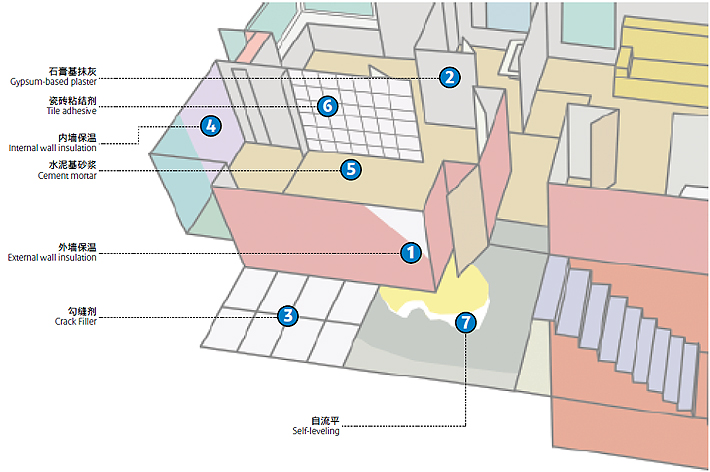Application of Hydroxypropyl Methylcellulose in Building Materials
In building materials, Hydroxypropyl Methylcellulose is mainly applied in the following aspects.
1. Latex and Latex Building Materials
Hydroxypropyl Methylcellulose, Methyl Cellulose, Sodium Carboxymethylcellulose, Hydroxyethyl Cellulose AND Methyl Hydroxyl Ethyl Cellulose are mainly used for thickening effects to make the paint achieve the desired storage and viscosity for construction, without severe delamination during storage or dripping and sagging phenomena during use. Due to their strong water absorption capability, they can quickly absorb a large amount of water and make the volume of themselves substantially increase and expand. So added to the emulsion, they can increase its viscosity and thus achieve thickening purposes. However, it should be noted that since the addition of them can reduce the water resistance of latex, in guiding the clients on the use of these products, the dosage should be minimized as possible under the condition of meeting the viscosity of the emulsion, that is, try to produce and use cellulose ethers with high viscosity and large molecular weight.
2. Underwater Anti-Discrete Concrete
There is often underwater construction in piers and bridges, but the ordinary concrete is not enough for solidification under water. The addition of the cellulose ether can make the concrete pouring under water not disperse or decrease the loss (0.1%~1.0%) resulting from water immersion. Even in the case of water flow, it can ensure the molding and solidification of concrete.
3. Thermal Insulation Surface Mortar for Exterior Walls
Improvement of living standards requires that modern buildings should have some insulation properties. Among various measures highlighted by the government, the insulation performance of wall has been strongly proposed. Now what is the most used is sticking a layer of foam polystyrene board on the line of exterior wall surface and then coating with a layer of surface mortar on outside it, but the bonding property between the foam polystyrene board and the surface mortar is poor. However, the addition of cellulose ethers in the mortar can not only increase the binding force between the two, but also can easily improve the workability and water-holding capacity of the mortar and make it not easy to crack.
4. Cement-based Plaster Mortar
The addition of cellulose ethers such as Hydroxypropyl Methylcellulose can improve the homogeneity of slurry, make the coating of plaster mortar easier, improve sag resistance, enhance the mobility as well as pumpability, increase the workability and thus improve the efficiency of construction. Since the cellulose ether has high water-holding capacity, it can extend the working time of mortar, improve work efficiency, produce high mechanical strength during solidification, control the infiltration of air, eliminate cracks of the coating and increase the surface smoothness.
5. Cement Mortar for Self-Leveling Floor
Cellulose ethers with low viscosity are widely used in self leveling. Self leveling is a very advanced construction technique. Since the whole ground is naturally leveled with very little interference of construction personnel, flatness and construction speed are greatly enhanced compared with the previous manual smoothing processes. In self leveling the dry-mixing time uses the excellent water-holding capacity of Hydroxypropyl Methylcellulose. Since self leveling requires the well stirred mortar automatically leveling on the ground, the use of water materials is relatively large. Adding Hydroxypropyl Methylcellulose will control the water-holding capacity of ground surface after pouring, bleed less obviously, lead to high strength of the ground after drying and small shrinkage, and thus greatly reduce cracks. Moreover, the addition of Hydroxypropyl Methylcellulose can also provide with the viscosity, function as the anti-settling additive, enhance mobility as well as pumpability, improve the efficiency of flooring.
6. Masonry Mortar
The addition of Hydroxypropyl Methylcellulose can increase the binding force with the masonry surface, enhance water-holding capacity, and improve the strength of mortar. Meanwhile, it can markedly improve the workability as well as lubricity, the construction performance and efficiency. For mortar with high water-holding capacity, it is also suitable for construction of high water absorbent bricks.
7. Extruded Concrete Slabs
The addition of Hydroxypropyl Methylcellulose can enhance the construction performance of extruded products, improve the bonding strength, lubricity and construction efficiency, and improve the wet strength of products and the bonding force of base sheets.

